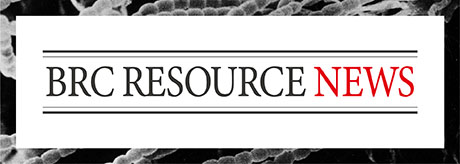Mouse E-cadherin full length cDNA (#RDB01184)
Mouse E-cadherin cDNA.
 Drawn by SnapGene® software |
|
| Alternative name | Mouse E-cadherin cDNA |
|---|---|
| Clone info. | Mouse E-cadherin cDNA from F9 cells cDNA library. |
| Comment | This clone contains a CDS fragment corresponding to the 69nt to 2723nt of X06115.1. Known differences (at least) : G to A substitution at 2714nt (Glu, synonym). |
| Vector backbone | pBluescript (Plasmid) |
| Size of vector backbone | 2.9 kb |
| Selectable markers | Amp^r |
| Growth conditions | 37 C, LB+Amp |
| Gene/insert name | Mouse E-cadherin/Cdh1 cDNA |
| Reference of insert sequence | X06115 (DDBJ accession number) |
| Depositor|Developer | Takeichi, Masatoshi | |
Distribution information
Please check terms and conditions set forth by the depositor, which are specified in the RIKEN BRC Catalog and/or Web Catalog.
| Ordering forms | Order form [Credit Card Payment MTA, for use for not-for-profit academic purpose [Word Approval form by depositor [Word Please visit Information of Request for Distribution.[link] For for-profit-research purpose, please contact us. |
|---|---|
| Terms and conditions for distribution | Distributed with written consent of Depositor. |
| Remarks | ((Additional form)) Approval Form(FormD) Please obtain written approval of the depositor. |
 [open/close]
[open/close]| 必要書類 | 提供依頼書 提供同意書 (MTA, 非営利学術目的用)[Word 寄託者による提供承諾書 [Word 手続きの概要は、「提供申込みについて[link]」をご覧ください。営利目的利用についてはお問い合わせください。 |
|---|---|
| MTAに書く使用条件 | 寄託者に許可をとること。 |
| 備考 | 【追加提供依頼書】承諾書(FormD) 寄託者の書面による提供承諾が必要です。 |
| Catalog # | Resource name | Shipping form | Fee |
|---|---|---|---|
| RDB01184 | Mouse E-cadherin full length cDNA | DNA solution |
JPY 9,460 (not-for-profit academic purpose) plus cost of shipping containers, dry ice (if required) and shipping charge |
How to cite this biological resource
Materials & Methods section:
| The Mouse E-cadherin full length cDNA was provided by the RIKEN BRC through the National BioResource Project of the MEXT, Japan (cat. RDB01184). |
Reference section:
| Nagafuchi, A., Shirayoshi, Y., Okazaki, K., Yasuda, K., Takeichi, M., Transformation of cell adhesion properties by exogenously introduced E-cadherin cDNA. Nature, 329, 341-343 (1987). PMID 3498123. [PubMed] [Article] [RRC of NBRP] |
Further references such as user reports and related articles (go to bottom)
References
Original, user report and related articles
| original | Nagafuchi, A., Transformation of cell adhesion properties by exogenously introduced E-cadherin cDNA. Nature, 329, 341-343 (1987). PMID 3498123. [PubMed] [Article] [RRC of NBRP] |
|---|---|
| user_report | Nag, K., E-Cadherin – Fc Chimeric Protein-Based Biomaterial: Breaking the Barriers in Stem Cell Technology and Regenerative Medicine. Advanced Materials Research, 810: 41-76 (2013). [Article] [RRC of NBRP] |
| user_report | Jovic, D., Direct observation of cell cycle progression in living mouse embryonic stem cells on an extracellular matrix of E-cadherin. SpringerPlus, 2: 585 (2013). PMID 25674414. [PubMed] [Article] [RRC of NBRP] |
| user_report | Meng, Q., The differentiation and isolation of mouse embryonic stem cells toward hepatocytes using galactose-carrying substrata. Biomaterials, 33 (5): 1414-1427 (2012). PMID 22118818. [PubMed] [Article] [RRC of NBRP] |
| user_report | Jovic, D., Control of singular cell cycle synchronization of mouse ES cells for hepatocyte differentiation on E-cadherin substratum. J. Biotechnol. Biomaterial, 1: 6 (2011). [Article] [RRC of NBRP] |
| user_report | Haque, A., The effect of recombinant E-cadherin substratum on the differentiation of endoderm-derived hepatocyte-like cells from embryonic stem cells. Biomaterials, 32, 2032-2042 (2011). PMID 21163520. [PubMed] [Article] [RRC of NBRP] |
| user_report | Nagaoka M., Design of the artificial acellular feeder layer for the efficient propagation of mouse embryonic stem cells. J. Biol. Chem., 283, 26468-26476 (2008). PMID 18614540. [PubMed] [Article] [RRC of NBRP] |
| user_report | Ito A., Enhancement of cell function through heterotypic cell-cell interactions using E-cadherin-expressing NIH3T3 cells. J. Biosci. Bioeng., 105, 679-682 (2008). PMID 18640611. [PubMed] [Article] [RRC of NBRP] |
| user_report | Rosshart S., Interaction of KLRG1 with E-cadherin: new functional and structural insights. Eur. J. Immunol., 38, 3354-3364 (2008). PMID 19009530. [PubMed] [Article] [RRC of NBRP] |
| user_report | Grundemann C., Cutting edge: identification of E-cadherin as a ligand for the murine killer cell lectin-like receptor G1. J. Immunol., 176, 1311-1315 (2006). PMID 16424155. [PubMed] [Article] [RRC of NBRP] |
| user_report | Nagaoka M., E-cadherin-coated plates maintain pluripotent ES cells without colony formation. PLoS One, 1, (2006). PMID 17183641. [PubMed] [Article] [RRC of NBRP] |
| user_report | Nagaoka M., Immobilized E-cadherin model can enhance cell attachment and differentiation of primary hepatocytes but not proliferation. Biotechnol. Lett., 24, 1857-1862 (2002). [Article] [RRC of NBRP] |
Resource search
Link
Other resources in our bankExternal Database
Mouse E-cadherin
Reference sequence
Tips
Featured content

